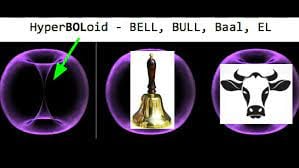The Torus Trajectory


A Google Search of "Egypt Ram"

A ram horn is much like the Golden ratio. It is a logarithmic spiral which has a equation of r=e^(a*theta). The r is the distance from the orgin, e is the Eurlers numer (around 1.618282) and the theta is the angle mesured in radian. The horn is just like the squares in which is starts and increases at a consistent rate. You just add the past two measurements together, then you have the next numer in the sequence.

Yubel in Hebrew. Strong's Hebrew: 3104. יוֹבֵל (yobel) -- a ram, ram's horn
Or yobel {yob-ale'}; apparently from yabal; the blast of a horn (from its continuous sound); specifically, the signal of the silver trumpets; hence, the instrument itself and the festival thus introduced -- jubile, ram's horn, trumpet. see HEBREW yabal
Strong's Hebrew: 3058. יֵהוּא (Yehu) -- "the LORD is He"
Notes on YE "HU",
Hú
In Hopi and Zuni dance rituals, Hú, also known as Huhuwa and Tithu, is the Kachina of the hummingbird.
The Hummingbird was, and is, an important bird in puebloan cultures. Hopi legend speaks of the Hummingbird as intervening on behalf of the Hopi people to convince the gods to bring rain. Even today Hummingbird feathers are highly prized and used ceremonially and in dance costumes. All Hummingbird Kachinas are depicted with a green mask and green moccasins. Hú dolls are carved from the root of the cottonwood tree.
During traditional ceremonies, the Hú dancer bobs while dancing and calls like a bird. His songs are prayers for rain to wet freshly planted crops in the spring, and women reward him with baskets of flowers; then they scatter to find him more flowers so the rain won't be scared away like a hummingbird might be scared away by a crowd.
The Hú dancer appears in both winter and spring ceremonies as well as the summer night dances in a lesser role.
These dances are often performed in underground ceremonial rooms which are only opened for the Hú dance.
Hu (mythology)
Hu (), in ancient Egypt, was the deification of the first word, the word of creation, that Atum was said to have exclaimed upon ejaculating or, alternatively, his self-castration, in his masturbatory act of creating the Ennead.
Hu is mentioned already in the Old Kingdom Pyramid texts (PT 251, PT 697) as companion of the deceased pharaoh. Together with Sia, he was depicted in the retinue of Thoth, with whom he was also occasionally identified.
In the Middle Kingdom, all gods participated in Hu and Sia, and were associated with Ptah who created the universe by uttering the word of creation. Hu was depicted in human shape, as a falcon, or as a man with a ram's head.
In the New Kingdom, both Hu and Sia together with Heke, Irer and Sedjem were members of the fourteen creative powers of Amun-Ra. By the time of Ptolemaic Egypt, Hu had merged with Shu (air).
Hu (surname)
Hu (胡) is a Chinese surname. In 2006, it was the 15th most common surname in China. In 2013, it was the 13th most common in China, with 13.7 million Chinese sharing this surname.
Some other less-common surnames pronounced Hu include 瓠, 護, 戶, 扈, 虎, 呼, 忽, 斛 and 壶. In Cantonese, “胡” is also pronounced as "Wu" or "Woo"
Hu (Sufism)
Hu or Huwa is a name for God in Sufism. Literally, Hebrew and Arabic for the English pronoun "He".
In Sufism Hu or Huwa is the pronoun used with Allah or God, and is used as a name of God. Allah Hu means "God, Just He!" In Arabic Allah means God and with Hu, as an intensive added to Allah, means "God himself." Hu is also found in the Islamic credo La Ilaha Ila Allah Hu: "There is no God but Allah," or in Sufi interpretation "There is no reality, except God", or in La Ilaha Ila Huwa meaning "There is no god but He".
(Strong's Hebrew: 3058. יֵהוּא (Yehu) -- "the LORD is He")
Hu (vessel)
hu ( Chinese: 壺; pinyin: hú) is a type of wine vessel that has a pear-shaped cross-section. Its body swells and flares into a narrow neck, creating S-shaped profile. While it is similar to you vessel, hu usually has a longer body and neck. The shape of hu probably derives from its ceramic prototype prior to the Shang dynasty (1600-1045 BC). They usually have handles on the top or rings attached to each side of neck. Many extant hu lack lids while those excavated in such tombs as Fu Hao's indicate that this type of vessel might be originally made with lids. Although it is more often to see hu having a circular body, there also appears hu in square and flat rectangular forms, called fang hu and bian hu 1 in Chinese. In addition, hu often came to be found in a pair or in a set together with other types of vessels. As wine had played an important part in the Shang ritual, the hu vessel might be placed in the grave of an ancestor as part of ritual in order to ensure a good relationship with ancestor's spirit.






The center portion of the torus looks like an hourglass, bringing to mind the words HOURS, HORUS, HORNS, TORUS and TAURUS.

No comments:
Post a Comment
Note: Only a member of this blog may post a comment.